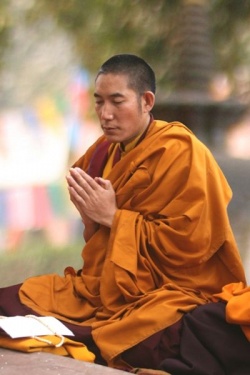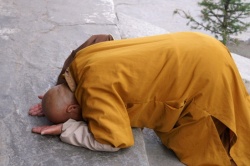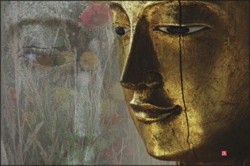Initiation/Empowerment
The Nyingma Tibetan Buddhism Tradition
The Nyingma School of Tibetan Buddhism is one of the 4 oldest Buddhist school in Tibet and has the richest tradition in teachings (hidden treasures) which are concealed and transmitted orally only to a disciple from his master. Its teachings, transmissions and lineage of enlightened masters have remained unbroken up to this date.
==Introduction==
Initiation or Empowerment (Tibetan: dbang) is the transmission of esoteric wisdom and realization from a qualified vajra master to the mind of the disciple. To the beginners, it is no more than a ceremony similar to the registration at school of learning; to the adept practitioners,
the Initiation ceremony also marks the empowerment of the meditative techniques for inner transformation, which is the esoteric path towards the accomplishment of the union of bliss and emptiness and therefore it is the progress towards the awakening of the inherent wisdom and enlightened qualities.
Since what is being transmitted is not mundane knowledge of any sort, but the enlightened wisdom that goes beyond our worldly knowledge and language, therefore the vajra master has to be a qualified guru who himself has first-hand experience in the ocean of wisdom of the reality described in the Buddhist scriptures. It is not any ordinary scholar who can fulfill the task in a qualified way, no matter how well-versed this scholar is in the scriptures of Buddhism.
The relationship between a master and his disciple is very much like that in a father and child. It is not a one-way relationship through which the disciple expects to receive “blessings” from the master. After the initiation, the master compassionately shares his attained wisdom through his skilful teachings (on both doctrines and meditative techniques) and knowledge of the unique traditions of a particular lineage,
while, on the other hand, the disciple should have faith in the master and the teachings received, the confidence in the primordial wisdom always present in its obscured form, and the diligence to practice the teachings so that the realization of the innate wisdom is possible. Go To Top
==The symbolic meaning==
In traditional Tibetan Buddhist practice, there are different levels of Initiation, corresponding to different levels of practice. In general, in the Nyingma school, four levels of Initiation are found: Vase, Secret, Wisdom and Verbal. While the detailed meanings of these different kinds of Initiation are too profound and
vast to be discussed here, they loosely correspond to the practice of Body, Speech, Mind, and the ultimate realization of nonduality/enlightenment. However, it should be noted that such a fourfold division of Initiation are not rote divisions that they might sound sometimes. They pertain to be
the means of entering into the esoteric path of awakening our innate wisdom and compassion. Hence, it is always important to realize the Initiation process is not merely a religious ritual; rather, the initiates should come to an understanding what the symbol meanings of the entire Initiation process lead us to realize,
including the offerings, the precept-taking, the paintings or statues of the meditation deities, the scepter and the belle sound of the traditional musical instruments such as the drum, the visualized mandala, as well as the Guru and his retinues, and other initiates who receive the empowerment with you. Go To Top
==The Ceremony==
As there are different kinds of Initiation, the actual procedure will also differ depending on the type of Initiation. In general, the process will begin with the Guru perform the deity in private, known as “the preparation of the Initiation” (dbang sgrub), as a way of preparing himself for the empowerment. It will
then be followed by refuge taking, the generation of bodhicitta, the precept taking, before the actual process of entering into the mandala of the meditative deity, usually symbolized by removing a blindfold that the initiates wear shortly before this entering process. Once “inside” the mandala, the initiates will receive the empowerment from the Guru, with various means to purify the initiates’ body, speech and mind.
==The Vajrasatta Purification==
During the Initiation, the main section involves the empowerments of the Five Buddha families. Such empowerments signify the transformation of the ordinary five aggregates (physical form, feeling, perception, volition and consciousness) into the five Buddhas, the [[five
great elements]] (earth, fire, wind, and space) into the five consorts of the Buddhas, and the five negative emotions (hatred, pride, desire, jealousy, and ignorance) into the five Buddha wisdoms. In short, it is a transformation of the phenomena in the domain of our defiled consciousness into a pure vision of the domain of our innate wisdom.
It might sound like a process through which external blessings are bestowed upon the initiates through the ceremony, however, the “empowerment” is actually a skilful means of symbolically signify a gesture that the initiates are introduced to the true nature of the minds and through which the innate qualities of the mind can be revealed while at the same time the illusory attachments and conceptual elaborations are naturally dissipating.
But the actual manifestation of the such innate enlightening qualities require the practitioners to first develop an insight into the true nature of the ordinary mental qualities, and through the meditative practice one can then abide in the nature of the mind, followed by the attainment of an initial glimpse into the
Thusness (reality; how things really are) through the natural liberation of the mind (Tibetan: sems nyid rang grol). All these practices, however, are founded on the understanding of the scriptural teachings and the
symbol significance of the visualization practice. And the “Vajrasattva Purification Practice” sets the very foundation of such a journey towards the attainment of wisdom. Go To Top
Frequently Asked Questions
==1) How can I tell I am ready for initiation/empowerment?==
When you are ready to receive further training in the esoteric teachings and when your teacher feels that you are ready to do so. By going through a formal initiation, you are granted the permission to study, hear and practice the Nyingma teachings that has been transmitted from the lineage of gurus.
==2) I am of a different religious belief.==
After I am initiated, do I have to give up my belief?
No, you do not have to give up your value system or religious belief. Buddhism is a philosophical teaching that shows the path to improve health by balancing the mind and body and balancing the body with nature/environment.
==3) How is the meditation teaching after initiation/empowerment going to be different from what I am currently doing?==
The current meditation teachings that are offered to the general public are simplified and adapted to the Western society. After initiation, the esoteric teachings will involve meditations using visualizations of dakinis, deities, mandala and recitation of verses and mantras. Bear in
mind that this is not a worship proceeding but it’s merely a meditation to practice the deity symbolic meaning and live accordingly. Before Buddha passed away, he asked his disciples not to erect any statues in his memory but to remember his dharma instead. However after several centuries, the students have a difficult time visualizing the guru during their meditation practice and thus his statues were built for that purpose and not for worship.
==4) What are my roles and responsibilities as a disciple?==
Respect your root and lineage gurus and the teachings.
Have faith in the teachings and yourself.
Be diligent in your meditation practice.
Have a good understanding of the teachings



